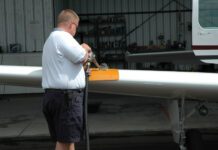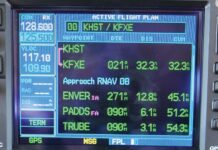by Bruce Chien
You can often complete an instrument flight successfully if something goes wrong with the airplane, the weather isnt what you expect or you make some mistakes in flying the approach. Sometimes, however, the wrong combination of circumstances or a poorly prepared pilot generate an accident report that blames improper IFR.
Simply put, improper IFR is a bureaucrats catchall condemnation that you didnt do it right. It can mean the procedure turn was on the wrong side (meaning improper side of the fix) into unprotected space. It can mean the airplane descended below minimums with consequences. It can mean going more than 10 nm out on the procedure turn into unprotected space.
An analysis of 21,000 NTSB records in the last 10 years found only 13 reports that specifically mentioned improper IFR, but the number is vastly greater because most reports cite the specific reason rather than the catchall phrase. Sadly, most accidents that involve improper IFR result in total destruction of the aircraft and the overwhelming odds that fatalities will be involved.
The catch is, virtually all are preventable.
Straighten Up and Fly Right
As a proficient and prudent instrument pilot, you may think pilots who fly improper IFR procedures dont affect you. In fact, they do. The uncharitable view – Hey you there. Fly right. Youre a-raising my insurance rates! – is exactly what you might think if you look at a few of the events.
The tale of the pilot of a Beech Baron who met with disaster in 1995 reads like this: The tower controller stated that after the airplane was airborne, he instructed the pilot to contact departure control. The pilot acknowledged, then no further transmission was received from the plane. Subsequently, the airplane crashed on a lake north of the airport. Two passengers survived. They noted no problem with the pilot or airplane before water contact. No preimpact mechanical problems were found. Probable cause: The pilots improper IFR procedure, by failing to maintain a positive rate of climb (and terrain clearance) after takeoff. Factors relating to the accident were: darkness, and the lack of visual references over water and under overcast cloud conditions.
Reading this, youre suddenly reminded that any pilot can get disoriented while transitioning to instruments. Still think the accidents only happen to the other guy?
Consider the pilot of a Seminole who was flying an ILS approach to a runway that reported a 300-foot overcast and three miles visibility with fog. The pilot and a safety pilot were both instrument and multiengine rated.
The pilot reported he had the current ATIS, however, during the approach the airplane collided with two pine trees that were between 100 and 150 feet tall. Impact occurred about a half-mile from the approach end of runway 11.
Probable cause, according to the NTSB, was the pilots improper IFR procedure by allowing the airplane to descend below the ILS glideslope and by continued descent below the decision height.
The question for every pilot to consider is whether the accident pilot just erred low or whether he was driven to get in and therefore intentionally busted minimums.
How about the Cherokee Six pilot who missed the NDB approach at his intended destination and diverted to an alternate airport about 15 minutes away to shoot an ILS. He told investigators the sequence of events from the miss to the crash was short and hurried.
Before I could remove the approach plate and review all the information I was already flying the DME arc, the pilot reported. I started down and started my transition back to instruments. The next thing I remember was hitting the ground.
The airplane crashed about 6 miles from the end of the runway. The NTSBs ruling: Probable cause: The pilots improper IFR procedure. The low ceiling and fog were a factor.
The moral of this story is that you should never rush into an approach. Ask for a hold or delaying vectors. Do your homework on the missed approach ahead of time, too.
We could go on and on with the pilots improper IFR procedure, by which he failed to maintain minimum descent altitude or the pilots improper IFR procedure by not initiating a missed approach at the outer marker, by attempting to intercept the glideslope from above after passing the outer marker or the pilots improper IFR procedure by failing to maintain the minimum descent altitude during the ILS localizer approach, which resulted in a collision with terrain short of the runway, but you get the point.
Pretty discouraging, huh? Looking at the events cited and others we would add if it didnt belabor the point, the lessons are to get on and stay on the instruments. Avoid get-there-itis. Dont go tired. Dont be rushing. Use the equipment per the POH and checklists. Finally, hope that whatever higher power you believe in protects you when youre stupid, because nobody else can.
The traditional response to low-frequency, high-fatality preventable accidents is to train. Interestingly, only one of the events we found in our search for improper IFR procedures was in a charter situation. The rest were part 91.
However, all were in fairly well-equipped aircraft, a number of them twins. All pilots were instrument rated. No shrinking budgets here.
What it boils down to that that most of the pilot errors were mental errors in that they could be directly traced to the pilot exercising either ignorance or poor intellectual discipline. So lets start with some mental exercises.
The First Task
Plan an IFR trip into a new airport. Mentally fly the whole thing through with 550-foot ceilings and 3 miles visibility all over the destination area. Ask yourself the questions that will influence the outcome of the flight.
What is the temperature/dewpoint spread? From where does the big weather picture predict about surface wind? Is there ice? Do all systems work? How about fuel?
Think about the approaches youll fly and your options if they dont work out. Youll come up with more questions.
Does the intended destination have an ILS? The alternate had better. If you miss, will you try again? In the event of a missed, can you identify the missed approach point and holding fix? Which approach at the alternate are you likely to fly? How do you navigate to that IAF? What en route altitude do you need to get to the alternate from the primary? Is there plenty of fuel? Will you need oxygen?
Write all this stuff down and take it with you. Update it in flight if necessary, but certainly be prepared for the trip to the alternate before you make the first approach at your primary destination. Its doubtful you can do all this planning while flying an approach.
Some years ago I was off on a ski trip when I heard a Gulfstream biz jet miss the VOR DME-C into Aspen. When the controller asked the pilots intentions, there was a long pause, and a standby.
Because its my personal policy never to be the first one to make a particular approach stick, I immediately asked for a diversion to my alternate, Eagle County, from my position at 16,000, 5 nm east of DBL. About five minutes later the GIII had to get in line behind me. That was a professional flight crew that hadnt done its homework.
Exercise Two
The next exercise is one for multi drivers. Take your favorite safety pilot along and fly the local ILS to the miss, in VMC.
Have your buddy pull a throttle at the miss and attempt to fly the missed approach procedure. My money is that you descend well below DH.
Go around and do it again, but this time fly the ILS at Vysse plus 10 or 15 knots. Same drill. Have your companion pull a throttle at the miss and attempt to fly the procedure. This time, you have an excellent chance at staying above DH.
A word of caution on the miss, however: Dont let speed deteriorate as did the King Air drivers at Eveleth.
Thirds a Charm
A third exercise applies to pilots of singles and multis. Head on out in the airplane and fly the nonprecision approach to your airport in VMC with no view limiting device. But fly it 200 feet low.
You will see that it seems really low. Be sure you dont harass the neighbors. There will be many things you encounter that didnt seem like hazards before because you never noticed them. Please dont hit them.
Want more? Follow this by flying the local ILS on the fourth dot low. The last two miles will scare the pants off of you. Youll never, ever do that again. Especially in IMC.
The Fourth Dimension
Holds. These exist not only for ATCs convenience, but for your breathing as well. Never mind direct, parallel and teardrop entries.
When given a holding clearance, you need be absolutely certain where the protected airspace lies. Never mind how you get into the protected airspace, just be certain you understand where it lies, and get into it the easiest way possible.
While this strategy may not serve you well on the practical exam, youll still be alive. And you still have your ticket, yes?
Improper IFR is category of disasters that are 100 percent preventable. Like a mentor of mine used to say, Its all in your head, son.
Youve got enough experience to know that the granite and trees win every time. And, as my mentor also used to say, Now dont you be doing that.
Also With This Article
“Tricks and Traps”
“Look Out Below”
“The Best Laid Plans…”
-Bruce Chien is an AME and CFII and owns a Piper Seneca. He routinely flies from Chicago to ski country in the winter.



